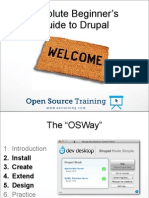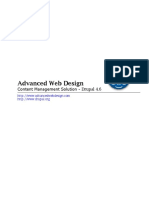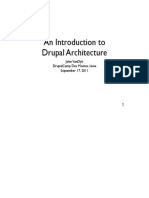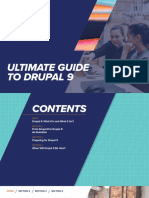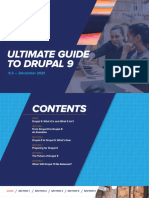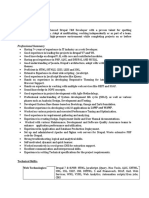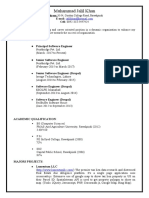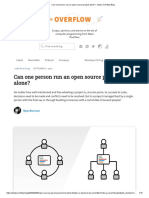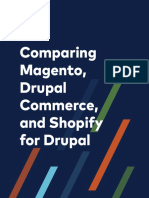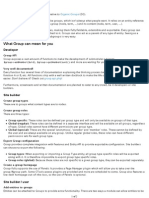DRUPAL
WHAT IS DRUPAL? Drupal is a web-based Content Management System.(CMS) A CMS is a website you build using the website itself. Drupal allows us to publish, manage and organize a variety of content on a website. It is a free software written in php. WHAT CAN DRUPAL BE? Blog Forum Online newspaper, Portal / Directory Brochure site, portfolio, flickr like photo drop Social community site, job post board Video site like youtube Project management site CRM, ERP, SCM, Wiki Shopping cart system E-learning, training site WHY DRUPAL? Modular and extensible Quality coding
�Standards-based Low resource demands Open source Ease of use Collaboration WHAT IS A UI? UI is a user-interface, which is a general term for the layout of options, widgets and settings used to configure the system or manage content. Site-building activities refer to configuring settings or managing content through the UI, such as building navigation menus. DRUPAL STRUCTURE Drupal is a database-driven (dynamic) application. It requires a database. Drupal has a core filesystem whose functionality can be extended using the UI itself, modules and themes. The UI settings are stored in the database. MODULES Packages of files in a directory that you upload into drupals module space (/sites/all/modules) Add functionality to drupal
�Core Modules come shipped with drupal Contributed Modules are downloaded from drupal.org THEMES Packages of files in a directory that you upload into drupals theme space (/sites/all/themes) Themes adjust the site layout and style. Like skinning your media player. Themes can be easily changed in the UI. DRUPAL DATABASE Drupals database tracks things like : Site and Module settings, Users information, Access information, Logging information, Permissions and User Roles, System Paths Content and content metadata. NODES A node is the primary form of content in a drupal site. At a minimum it is a title and a body, and can be specialized. A page and story for example are node types that have a specific node settings.
�A node type is a blueprint for creating instances of content of a particular type. Not everything in Drupal is a node. Ex: A user is not a node. A taxonomy is not a node. An account is not a node. LAYOUT AND REGIONS A Region is an area in a layout, such as a header, footer, content, left/right sidebar into which blocks can be placed and arranged. A block is a box containing some information A node resides only in the content area of the layout (except in special circumstances). Think of the content region as a big node block that allows other blocks in it but the node itself cant move. BLOCKS Blocks are added by modules. Blocks can contain views, widgets, menus, nodes (in special circumstances), and panels. Blocks can be moved around through the UI Blocks can be styled individually.
�ADMIN MENU The administrative menu is a part of the UI that allows one to configure Drupals settings. The settings available depend on which modules are installed and enabled. Permissions allow users to have administrative access to module settings. USERS All CMSes have a user login system; users have a username/pw. Drupal also supports the concepts of 1) Roles and 2) Permissions. Roles are user designations to groups having the same set of permissions. ANONYMOUS USER A (not-logged-in) site visitor is called a guest, visitor or anonymous user. Has a user-id (uid) of 0 (zero). All anonymous users belong to the anonymous user role (a role ID of 1) and have a set of permissions assigned to them. AUTHENTICATED USER A user in drupal may belong to one or more roles.
�Every registered user in Drupal belongs to at least the authenticated user role. Authenticated user role has a role ID of 2 ROOT ADMIN USER The root user or root admin has the ability to do anything on the site and is a special user. The root user has a user-id (uid) of 1. The root user does NOT have role-permissions to set because they are effectively gods within Drupal. MANAGING PERMISSIONS Key concept: If you grant permission to an authenticated user, it applies to ALL roles except the anonymous user. To grant a permission to everyone on a site, you must grant the permission to both the anonymous user and authenticated user. To grant permission to only a newly created dentist role, tick the permission on that role. Leave all the other roles deselected. If you grant to both the dentist role AND the authenticated user role, you would be doing it wrong. Drupal assumes you know this.
�HOW TO LOG ON TO DRUPAL http://environment.wku.edu/drupal/ To create an account on Drupal just click the link under the User Login area (located in Red) that says Create new account. Next, follow the instructions to fill out the required form. The page shown is the Home Page. The home page will give you a description of CWRS and gives a list of upcoming events
�MORE OPTIONS You can subscribe to the mailing list. My unread is where you can check post within your groups. Polls is where you can vote on ideas by other members or if you chose to add a poll in create content you can take a poll of the other users. Recent Posts is where you can see other users content that has been recently added. There is a search if you are looking for a specific topic. My account lets you update your information and look at your recent history. You can view the user list to view all other users. On the right hand side of the home page you can see who is new to the Drupal site and what users are now online as well as the current weather.
�CHANGING YOUR ACCOUNT SETTINGS Choose My Account. Click on the edit tab. Underneath the edit tab you can edit your password, theme, time zone, etc.
�CREATING AND EDITING YOUR NEW CONTENT At the top of your personal menu, you'll find a link called "create content". Under create content there are a list of contents that can be edited. Choose content (poll, book page, blog entry, etc.) in blue. This will bring up a form to fill out in order to create your new information. In order to edit information, you must be on the page you wish to edit, and it must contain an edit tab.
�These tabs are usually on pages that you have enter information on. This will allow you to edit or delete your own work.
















